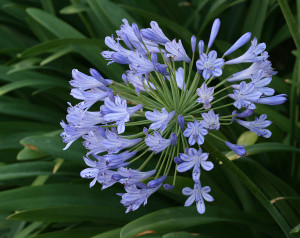Sometimes the universe sends signals so strong they simply can’t be ignored. In my case, those signals add up to a cosmic call of the Nile.
Over the past few weeks, I have been seeing trailers for the latest screen adaptation of Agatha Christie’s great mystery, Death on the Nile. It has an all-star cast, an exotic setting and gorgeous costumes, not to mention the luxuriously mustached Kenneth Branagh playing Christie’s infallible sleuth, Hercule Poirot.
My dining room has neither Branagh nor Poirot, but it does have an all-star cast of plants, including the exotic sounding lily of the Nile. The plant is clad in simple green leaves, and situated in a fetching faux-Grecian urn. Every day my lily of the Nile hints strongly at a need for division and replanting.
I will take the universe’s signal and do two things as soon as possible—see Death on the Nile, and decant my Lily of the Nile. The former will improve the quality of my life; the latter will boost the quality of flowers that the plant will produce later on.
The ancestors of my lily of the Nile, or Agapanthus, as it is known botanically, never saw Egypt or even the smallest Nile tributary. They did, however, hail from Africa, specifically parts of South Africa and Mozambique. Plant taxonomists love to fuss with names and classifications, and over time, agapanthus has resided in the lily, amaryllis, and onion genera, before returning to the amaryllis genus. After all that wearisome traveling, agapanthus was finally parked in its own genus, Agapanthaceae.
The generic confusion is somewhat understandable, because the plants have trumpet-shaped individual flowers that look a bit like those of amaryllis or lilies, but those flowers form into large rounded clusters or umbels, like some members of the onion family. The upright, strap-like leaves might fit into any of those genera.
Fleshy-rooted agapanthus plants first found their way north as they accompanied European explorers returning from southern Africa in 1679. The Latin genus name comes from the Greek “agape” for “love” and “anthos”, meaning “flower”. I suspect the “lily of the Nile” sounded exotic and romantic to someone with enough influence to stick it firmly to the plant.
No matter what you call it, agapanthus is gorgeous. Rising from generous clumps of arching leaves, the flower stems may be up to 48 inches tall. Mature plants may produce many big umbels during the late spring and summer with flowers in all shades of blue, from very pale to dark blue-purple. White hybrids are also popular. Though perennial, agapanthus is not hardy in cold winter areas, so many people either treat them as annuals or overwinter them inside.
Browsing the catalog and online offerings, you can see that breeders have had more than a few flings with lily of the Nile. The plants also hybridize freely with one another, so growers sometimes find new and different agapanthus surprises in their fields or green houses.
Some hybrid offerings are statuesque, like ‘Mood Indigo’, with darkest blue flowers on three to four foot stalks. ‘Stevie’s Wonder’ is similar in color, with somewhat shorter stalks. ‘Twister’ is also tall, bearing orbs of bi-colored trumpets that are white at the petal tips and violet at the bases.
For something small, dark and handsome, try ‘Back in Black’, with dark blue flowers and purple stems that rise to only two feet. Even shorter at 12 to 18 inches tall, with near-black flowers, ‘Black Pantha’ will succeed nicely in containers. ‘Peter Pan’ is also short, with stems topping out at 18 to 24 inches and sky-blue umbels.
Generous balls of clean white flowers pop up in several varieties, including ‘Bressingham White’, which is tall, at about four feet; and the slightly smaller, ‘Getty White’, which sports stems between two and four feet tall.
The best display of agapanthus that I have seen was at an estate garden where an allee of sky blue specimens growing in large tubs lined a long walkway that led to an ornamental water feature. Since the estate was in a cold winter area, I suspect that it took several strong individuals to get those tubs into winter quarters.
Unlike some great beauties, lily of the Nile is relatively unfussy. Outdoors they grow best in free-draining soil warmed by full sun or the lightest possible shade. Laziness is a virtue with agapanthus, as they do best when slightly pot-bound. Eventually though, the day will come when the plants will start pushing out of their containers and need division. Don’t be afraid; be bold. Take the plant out of the container and apply a sharp garden knife to cut the agapanthus into divisions, making sure that each division has a generous serving of attached roots. Repot in fresh soil, water thoroughly and feed with a balanced fertilizer, diluted, if necessary, according to manufacturer’s directions.
If you are overwintering plants, water infrequently and position in a sunny indoor space. Return them to the garden when night temperatures are consistently above 50 degrees Fahrenheit.
People with money to spare can buy enough agapanthus for an allee fairly easily. If you do not fit into that category, buy several, treat them well and divide as they outgrow their containers. Check out the offerings at Plant Delights Nursery, 9241 Sauls Rd, Raleigh, NC 27603; 919-772-4794; www.plantdelights.com.

